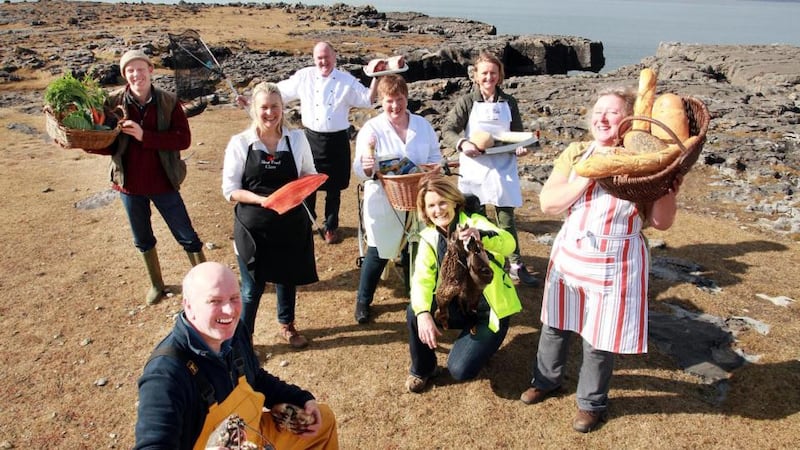'You can't eat the scenery," people used to say. A beautiful landscape, in other words, couldn't generate an income. We've come a long way since then, particularly in parts of the country such as the Burren, where the landscape, particularly the Cliffs of Moher, draws hundreds of thousands of tourists a year. But tourism has to be managed, both to preserve the sight they're coming to see and to interest them in the area's broader heritage.
“The Burren has almost a million visitors a year, over half of whom come to the Cliffs of Moher – Ireland’s most visited natural attraction – on coach tours. Many others just pass through, and less than 3 per cent stay over. The challenge is to get people to stay a little longer and involve them in outdoor activities,” says Tina Dwyer, who co-ordinates sustainable tourism at Burren & Cliffs of Moher Geopark.
The geopark has just been shortlisted for the World Responsible Tourism Awards, along with Loop Head Peninsula, nearby in Co Clare, which The Irish Times chose as the Best Place to Holiday in Ireland earlier this year in part because of its commitment to sustainable tourism.

Sustainability
"Sustainable tourism", "ecotourism" and "responsible tourism" might seem to be interchangeable terms. But there are subtle differences.
“Ecotourism” generally refers to experience-based activities that bring visitors up close with the local landscape. It can also refer to accommodation that respects the environment, such as through recycling, leave-no-trace policies and the use of renewable energy.
“Responsible tourism” and “sustainable tourism” are more interchangeable. “The ethos of sustainable, or responsible, tourism is [that it] is good for the environment, good for the local community and good for the visitor,” says Dwyer.
“It’s all about merging tourism with preservation and conservation and working out what should happen where,” says Dr Douglas Comer of the International Committee on Archaeological Heritage Management, one of the speakers at a conference the geopark is hosting later this month on how to balance conservation and tourism.
Comer says a heritage site can cope with lots of tourists if it limits the time they can spend in sensitive areas and broadens the visitor experience. The underground visitor centre at the Cliffs of Moher and a new interpretative centre and cafe at the Giant’s Causeway are examples of this approach, he says.
“It’s all about visitor flow and giving people opportunities to go to other places to learn about the site – the cafe, the bookstores, see a movie – and then become an advocate of the site,” says Comer. He says museums and historical sites should develop niche-tourism opportunities to help themselves stay economically viable.
Another of the speakers is Erika Harms of Solimar International, a consultancy that helps to market sustainable tourism. She believes in “the transformative power of sustainable tourism, bringing economic prosperity to destination and communities whilst preserving their natural and cultural riches”.
“Tourism is a commodity, and responsible-tourism operators will look for opportunities to get people to stay longer,” she says. “For instance, the Inca Trail, in Peru, is a very popular site, and Machu Picchu” – the fortified Inca town in the Andes – “is overvisited, but there was no overspill into the local economy. We developed a women’s weaving co-op, which provides another interest for visitors and job opportunities for young women.”
Burren Food Trail, which started this year, is a similar example of a tourism initiative that involves local businesses working together to create new experiences for tourists. “Don’t just visit the Burren,” the group says. “Taste it.”
Visitors can take a guided mountain walk, or go surfing, then try local goat’s cheese, beer and smoked salmon. Guides also bring up to 15 people on caving, sea-kayaking, rock-climbing, canoeing and mountain-biking trips. Weekly guided cliff walks from Doolin to Liscannor also began this year.
Burren & Cliffs of Moher Geopark wants to teach local tourism providers about the area’s heritage, so that they are the ones who can then tell visitors about the landscape around them.
“We’ve also learned the hard way on expensive certification processes and now realise that it’s about promoting inclusivity and access. Really, it’s all about what’s good for the area is good for everybody. We have expectations for tourist behaviour, but the key is that the providers communicate this to visitors. Once visitors get a sense of the culture of care, they will behave responsibly,” says Tina Dwyer.
Fáilte Ireland is now aboard the sustainable-tourism bus, with a series of environmental action plans. The geopark's sustainable-tourism conference aims to further develop this commitment by presenting its findings to the Department of Tourism.










